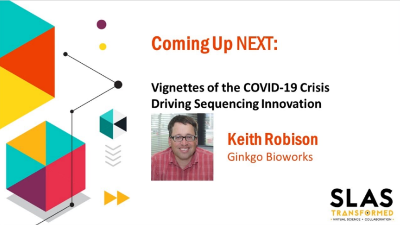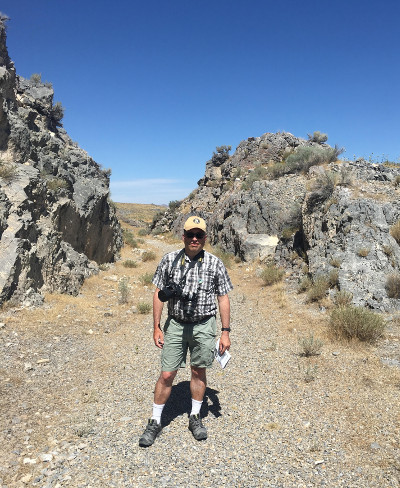
November 2, 2020
Computational biologist Keith Robison enters the race to find answers for the COVID-19 crisis armed with more than 20 years of drug development experience that ranges from the discovery of a homolog of one of the most valuable drug targets ever to developing a compound now tied to screening the virus.
When he thinks back to his introductory textbooks in college, Keith Robison, Ph.D., considers how much of the material was discovered before World War II. “Take physics, for example. This was a rigorous, two-semester course taught by someone who was great about bringing new ideas and current events into his lectures,” he says. “However, the information in the textbook at that time also was available when my grandfather was in college. It ends with Maxwell’s Equations – something discovered in the 1800s.”
He notes that biology writes a different story. “A freshman-level college textbook for biology that covers the same rapidly unfolding scope of the science would be focused on what happened in the last 30 years,” says Robison. “It would have discoveries such as CRISPR from the past decade, the discovery of RNAi from the 1990s and PCR from the mid-1980s.”
A current plot twist in this phase of life sciences is the COVID-19 pandemic – something scientists knew was coming, just not when, according to Robison. In spite of this, “it is interesting how quickly the genomics space has responded to the challenge of COVID-19,” he says. “Particularly how DNA sequencing technology has been rapidly iterated.”
According to Robison, a principal scientist at Ginkgo Bioworks (Cambridge, MA, USA), researchers developed new sequencing to determine the agent of SARS-CoV-2 in a matter of weeks. “The numbers show well over 50,000 sequences of the virus from all around the world. While there are concerns about certain parts of the world where we don’t have as many sequences, it’s still extraordinary how quickly this technology was deployed for this problem.”
Ginkgo Bioworks found itself in the midst of an unplanned next chapter of the story. “Gingko had no plan to go into diagnostics,” Robison explains. “It always has been a platform company, however, one of the company’s core capabilities is the ability to reposition. As COVID-19 hit, we watched the numbers going up in January. I remember thinking, ‘someone’s going to fix this, right?’ By February, we were discussing what Ginkgo could contribute.”
Eight months and thousands of research hours later, the Ginkgo team filed for an Emergency Use Authorization (EUA) with the U.S. Food and Drug Administration (FDA) to launch their technology called Concentric by Ginkgo, a surveillance testing method for the virus in schools and workplaces. Using next generation sequencing (NGS), Concentric by Ginkgo tests cumulative samples from small populations of people – such as college campuses, workplaces or even sports teams – at a decided-upon interval to predict where clusters of virus cases might emerge. The Ginkgo team has nearly completed construction of a facility that is anticipated to process 250,000 pooled samples a day with a 24-hour turnaround time.
The Race for Answers

Robison, who has spent his more than 20-year career using computational approaches to solve biological and chemical problems in drug development, is now deeply involved on the diagnostics front. He tracks the endeavors of many different sequencing technologies and gave a presentation on their progress in unraveling COVID-19 during SLAS Transformed, a virtual conference hosted in June of this year.
“Less than 48 hours after I completed the pre-recorded portion of my presentation for SLAS Transformed, in which I stated that there wasn’t a sequence-based diagnostic for COVID-19, the FDA announced that it approved Illumina’s sequence-based approach. I knew it was in the works, but it’s still amazing how quickly it developed. It’s a reminder of how rapidly this field can move and will continue to progress. The pace to deal with this pandemic is ferocious.”
Robison comments that he has never experienced such an intense time and place “especially in an R&D setting,” he says. “I have worked at places in the past where sometimes we needed to move fast to get our next round of funding, and once in college I was part of a production group for a diagnostics developer. In that position, we constantly had to push weekly kits out the door. Now that had its issues, but it wasn’t R&D. It’s difficult to make predictions with any real accuracy in R&D, and rapidly growing out a diagnostic at higher and higher levels is an effort challenged in many aspects.”
Supplies are the first problem. “People joke about the lack of toilet paper, paper towels or disinfecting wipes, but the shortage of PCR master mix for biomedical R&D is no joke,” Robison continues. “It’s not that people are hoarding it; it’s just that demand went through the roof.”
Staffing is the next issue. If there is a viral outbreak in a research team, “how do you cross-train to fill spaces in personnel?” Robison questions. “Training happens by standing over someone’s shoulder or even face-to-face. It’s difficult to do that six feet apart.”
The ultimate challenge in any drug discovery venture with an accelerated timeline, says Robison, is introducing research into the human population. “The sobering reality about the COVID-19 vaccine development is that you’re going to be giving these vaccines to billions of people,” he continues. “There may be rare side effects that won’t show up until you get into high numbers of recipients. There’s no way to reflect that outcome in computer or animal models or perfectly predict it in any other way. You do your best with all your preclinical models and testing, but ultimately you have to put it in people and look for effects because biology is so insanely complex.”
He offers E. coli research as an example. “Here’s a lab organism used to make many things in life sciences. We have been sequencing its genome since 1997, but we still don’t understand the function of hundreds of E. coli genes. It should make you very humble to consider reprogramming biology or developing drugs for the human genome.”
He compares the pace of pandemic research to efforts of the past when disease outbreaks threatened the populace. “When I was in high school, the AIDS epidemic blew up,” Robison says. “It took years to culture the virus and figure out what it was. HIV unfolded slowly because it was tedious building a database of different HIV sequences in a variety of patients. Researchers used the database to build a better understanding of the mutation rate, but it was slow work because not a lot of people knew how to do it and the technology was expensive.”
The groundbreaking work in AIDS research laid a foundation for the 2003 global outbreak of severe acute respiratory syndrome (SARS). Research moved quicker during that pandemic because sequencing was much more developed. “Every time humanity has faced something awful – like war or pandemics – we have pulled something good from it,” Robison says, adding that researchers learned so much about SARS-CoV-2 in nine months because they applied known sequencing strategies and instruments to this push.
“All three major sequencing platforms have developed procedures that generate material in a way that is conducive for that technology,” Robison comments. “I mentioned these during my SLAS Transformed presentation. Illumina uses short reads, PacBio requires long reads and Oxford Nanopore falls somewhere in the middle. It’s interesting to me to see all the creativity that has been applied.”
The creativity is essential because the virus is tricky, Robison contends. “Previously sequenced HIV and influenza, for example, have a much smaller genome compared with the larger SARS-CoV-2 genome. So our next question is, how do you deal with scaling up when the genome is so much larger? The only way we’re going to get the scale we need is through automation.”
Ideally, Robison comments, the SARS-CoV-2 outbreak will get governments more serious about disease outbreaks, “so that when the next one comes – because there will be a next one, unfortunately – we’ll be better prepared,” he continues. “A lot of the learning and infrastructure of this event will carry over to the next event, particularly some of the approaches that haven’t yet come online.” An example he mentions is the isothermal process used by Oxford Nanopore’s LamPORE that doesn’t require a thermocycler.
“You just need a calibrated hot plate to heat water to boiling, and then cool it to the right temperature for 15 minutes,” he explains. “This technology may be an attractive assay scheme for low-resource environments, and approaches such as this may have a life after COVID-19 to address serious problems in agriculture around the world. My hope is that we get a few silver linings out of this tragic event.”
A Life in Science

At Golden Spike National Historical Park -- a neat intersection of Robison’s interests in history, railroads and geology. He says there was “no automation here -- this was cut out by gangs of men with black powder and hammered drills!”
Robison has always pursued his career with a sense of awe. “This whole world of the microbiome has just exploded in the last 20 years,” he comments. “We’re finding microbes in places no one imagined, such as solid rock and oil deposits. We’ve discovered archaea living in water that would be boiling if it were at surface pressure. At the other end of the spectrum, there are things living in Antarctic ice environments. What does this mean? It should be explored.” In an SLAS New Matter podcast interview he added: “However weird you think the biosphere is going to be, it's much weirder.”
The microbiome of the human body is no different. Robison contemplates how often chemotherapy fails because gut bacteria knocks down the agent or destroys it completely. He considers how many times serious illnesses arise due to metabolites made by gut bacteria, or how often our own bacteria protect us from disease.
“We’re still discovering things,” continues Robison, whose career journey involves many facets of drug development from working with genomics and proteomics technologies and a variety of protein and metabolic engineering projects, to monitoring a high-throughput gene synthesis facility and applying genomics to natural product drug discovery.
“I have been around a lot,” Robison says, summing it up with a laugh. “Some people know what they’re going to do and they execute on that – I’m more of one who pursues cool projects. Everyone has to do what works for them, and one of my skills is rapid adaptation.”
Robison discovered this skill as he completed his Bachelor of Science degree at the University of Delaware and began applying for graduate school. “Right before Christmas my senior year, my advisor took me aside and, as gently as he could, told me laboratory research wasn’t my strength,” Robison says. “Part of it is my easily distractible phenotype!”
As a result, Robison sent out grad school applications with a computational focus. This unusual approach happened around the time the Human Genome Project launched, and Robison landed at Harvard University in a joint position between Walter Gilbert, Ph.D., who developed one of the first DNA sequencing approaches, and geneticist George Church, Ph.D. “In my department, I’m fairly sure I was the second person to ever get a dry Ph.D. There were no lab experiments in my thesis,” he comments.
While in graduate school, Robison made the decision to go into industry. “In Boston at that time, people were leaving labs and going to startup companies,” he explains. Joining Millennium Pharmaceuticals Inc. (Cambridge, MA, USA), he first developed a variety of DNA and protein sequence analysis tools to support the discovery of candidates of novel therapeutic protein and small molecule targets. As his work with the company progressed, Robison provided computational and statistical support across the pharmaceutical research and development spectrum. During this time one of Robison’s screens revealed a homolog of one of the most valuable drug targets ever discovered, ACE 2, making him the co-author of multiple patents and assays for this target.
“Millennium developed compounds against it and screened them for multiple disease indications,” Robison comments. “It was a bit rushed, but it even went into a Phase 1 clinical trial.” For a long time, Robison didn’t think about the target gene. “It was just something I worked on,” he says. He moved on to other jobs, including stints with Codon Devices (Cambridge, MA, USA), a biotech startup founded by George Church, Infinity Pharmaceuticals (Boston, MA, USA) and then Warp Bio (Cambridge, MA, USA).

Hiking at beautiful Olympic National Park.
“Then one Thanksgiving I was at a hotel with family, and I saw my gene discovery from Millennium on the front cover of the New York Times!” he continues. The article revealed that ACE 2 is a receptor for SARS. The reason that it made headlines that day was the discovery that it also is a co-receptor for SARS-CoV-2.
It’s not the first time his work has intersected with the virus. “In R&D, you can’t predict what you’re going to discover – huge pivots can happen,” he comments. “At Warp, our goal was to use a particular strategy to discover new compounds of important medicinal interest. We discovered new compounds by our strategy, but it’s not clear they had medicinal value. However, in this weird epicycle, it turns out that one compound we discovered, WDB-002, might be relevant now to COVID-19 and might be beneficial in screening.”
He contemplates his career moves. “Networking and these epicycles in the science keep pulling me forward,” he says. “When I came to Ginkgo in February 2019, I thought I’d be doing nothing but genome sequencing and thinking about how to build biological circuits and advanced assays. My projects have been a mix of those carrying obvious societal impact and those that simply had market value. Ginkgo handles a smorgasbord of projects, such as making a compound for a flavor or a fragrance. Some commercial projects help you develop technology that can then be applied to something more challenging and medically relevant,” Robison comments.
“Projects such as COVID-19 diagnostics and cancer therapies are more meaningful to me and have a clear, societal benefit,” Robison says. “Being in my 50s now, I find with increasing regularity that I have family and friends fighting diseases such as cancer. It is definitely intellectually interesting to pursue these problems, but then it becomes personal.”
Sidelines
SLAS New Matter Podcast with Keith Robison: Jurassic Park Culture and Dirty Sinks
Learn the Latest from Computational Biologist Keith Robison in His Blog, ‘Omics! ‘Omics!
Ginkgo Bioworks Among Winners of NIH’s ‘Shark Tank’ for Covid-19 Tests
From SLAS Discovery: Read More about Applications of Functional Genomics for Drug Discovery
Ginkgo Bioworks Awarded $40MM NIH RADx-ATP Contract to Expand High Throughput SARS-CoV-2 Testing
